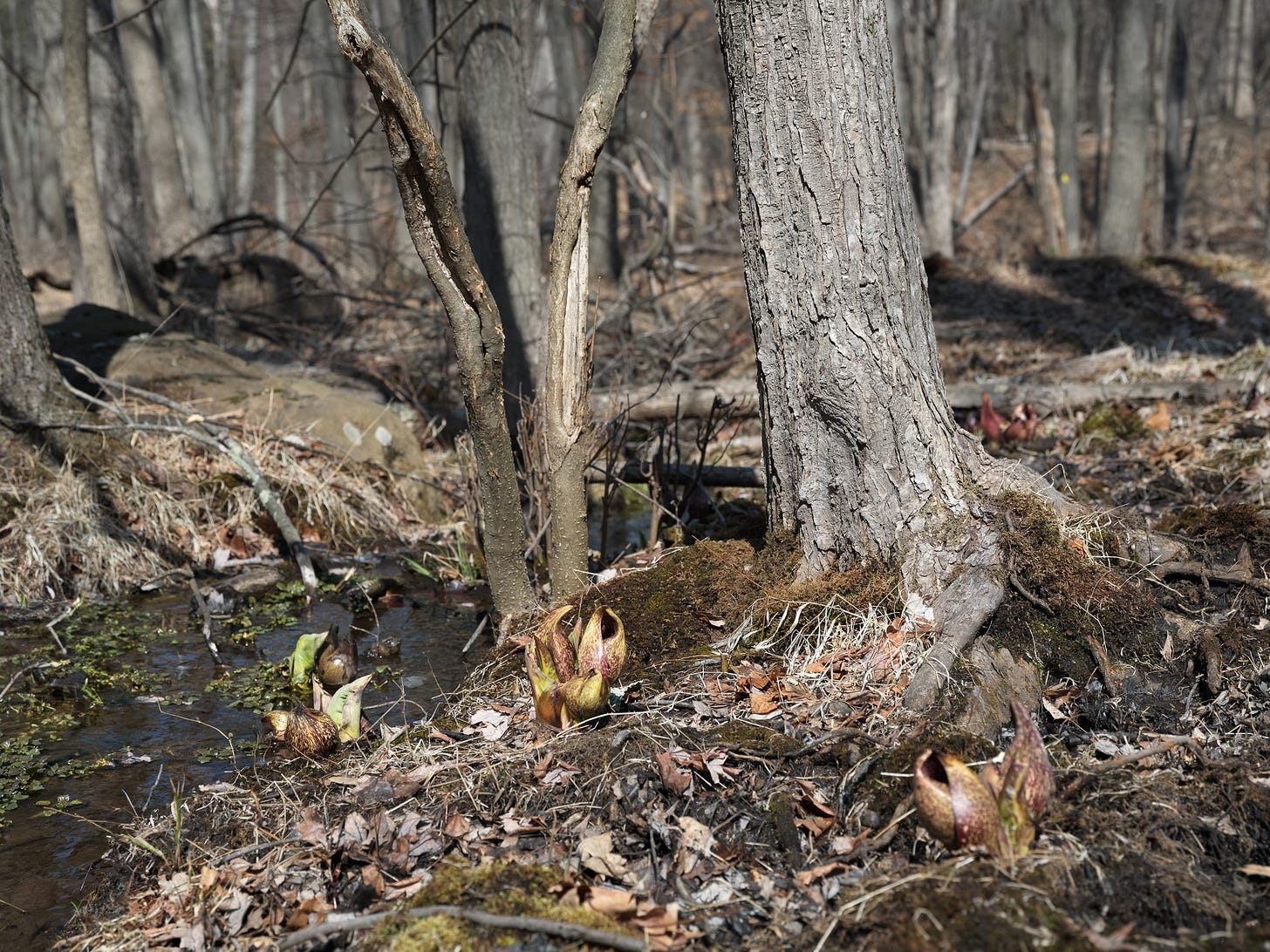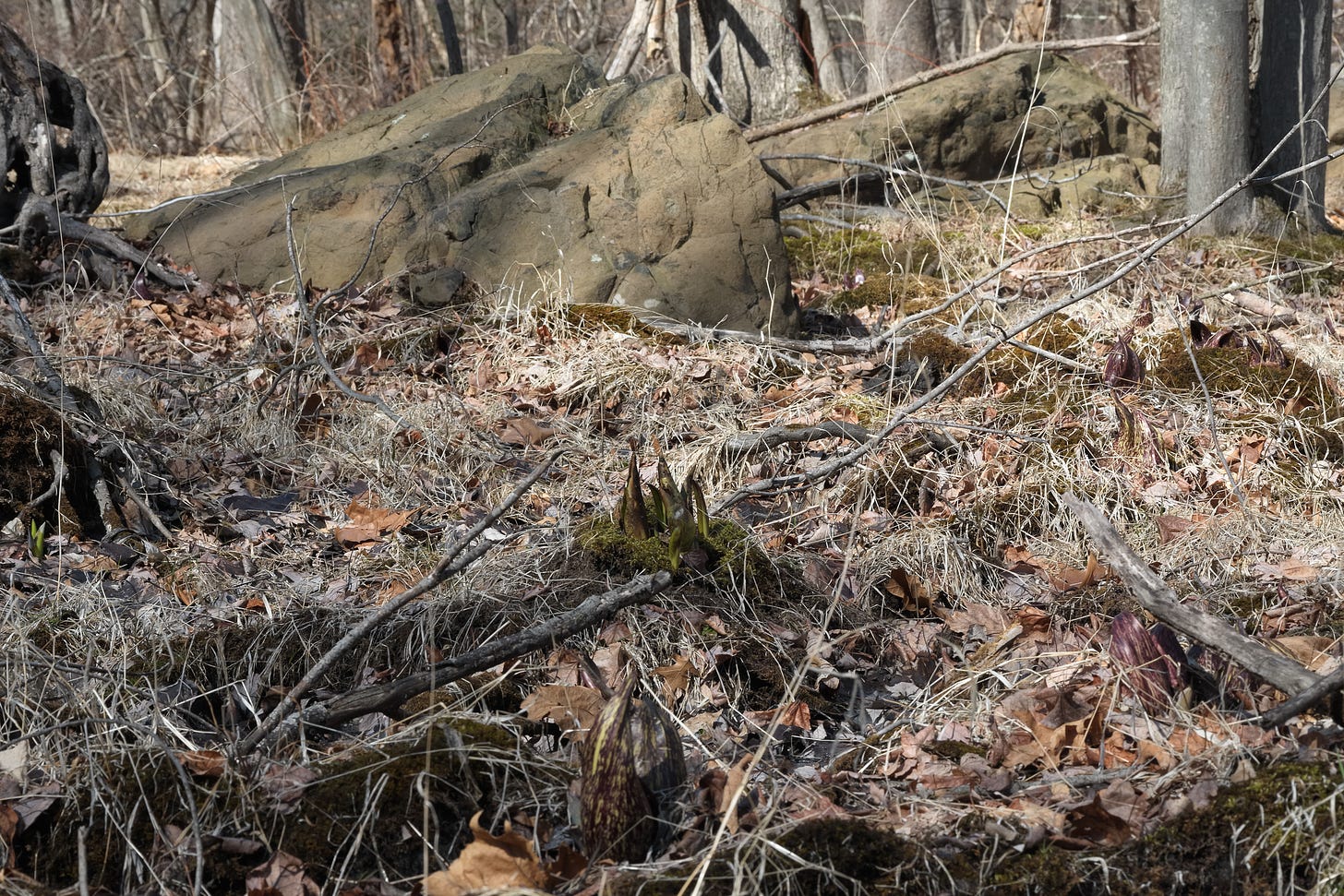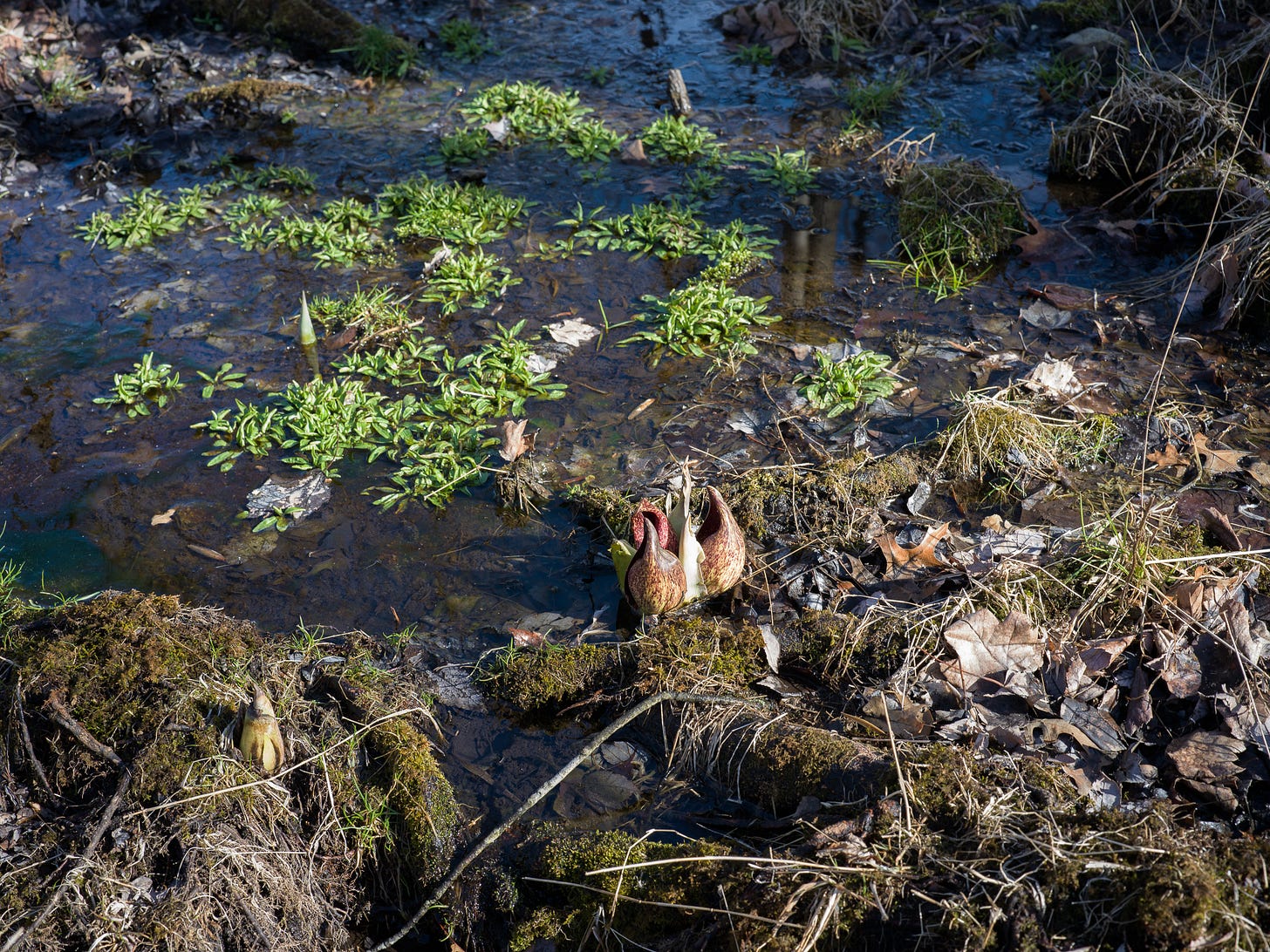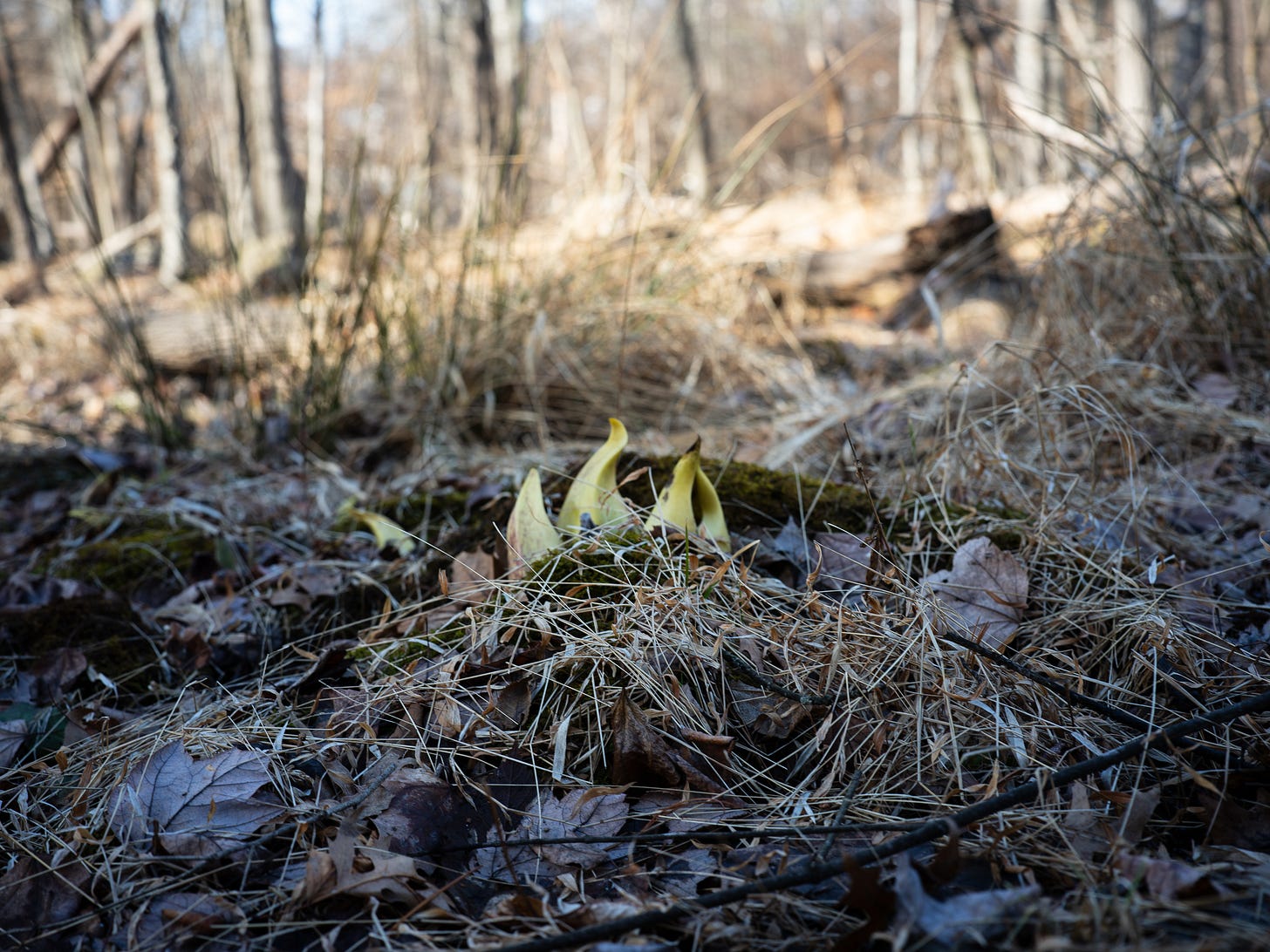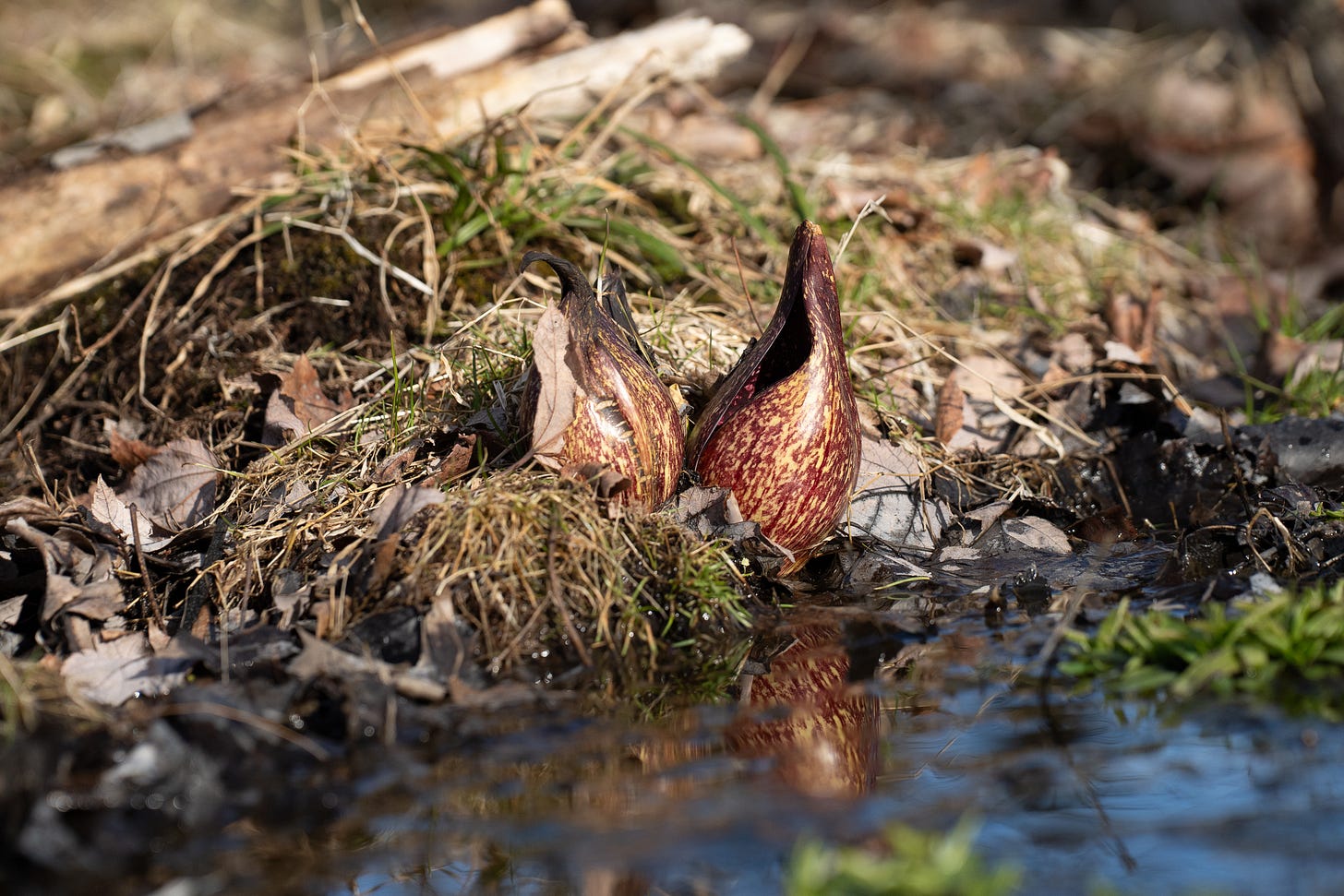skunk cabbage and the entropic landscape
from the florilegium at highland house, a native plant gardener's logbook
I’ve neglected the Florilegium, my native plant gardener’s logbook, for too long. Some readers may be here primarily for that; for you, this post marks a return. It addresses a botanical harbinger of spring, promising more reflections on gardening, nature, and plant ecology in the months ahead. Readers interested in my writings on art and technology should find resonances here as well. Robert Smithson’s influence runs through this essay—not only conceptually, but stylistically. My language inevitably takes on the texture of his thinking. This return to the Florilegium feels fittingly entropic, as gardens themselves reflect cycles of neglect and renewal. In a moment marked by climatic uncertainty and ecological imbalance, engaging deeply with plants becomes more than horticulture—it becomes a meditation on survival, adaptability, and hope.
As always, I deeply appreciate it when you share my substack and—for better quality images, please do read this on my site: https://varnelis.net/the-florilegium/skunk-cabbage-and-the-entropic-landscape/
It’s just the Ides of March, when omens become outcomes. The Earth itself seems caught between prophecy and decay, a time the Romans considered a deadline for settling debts. Named after Mars, the Roman god of war, this month signals conflict and transformation. In Lithuanian, March is “Kovas.” Although some etymologists connect “Kovas” to Corvus frugilegus, the rook (also kovas), a palearctic relative of the crow, the Lithuanian word also aligns with the Latin sense of battle—”kova” meaning precisely that—highlighting the month’s climactic struggle between winter and spring. The skirmish commences earlier, in February, marked in Lithuania by Užgavėnės, a folk festival in which Kanapis (Hemp-man or Cannabis-man), embodying the renewal of spring, ritually vanquishes Lašininis (Pork-man or Fat-man), symbolizing winter’s sluggish inertia. Užgavėnės was originally known as Ragutis (after the Lithuanian god of ale and fermentation) and celebrated by the Lithuanian pagans at the time of the spring equinox, but with the forcible Christianization of the country after the Northern Crusade, it became associated with Shrove Tuesday. It’s worth noting that my grandfather, a folk artist living in the village of Alsėdžiai, deep in the province of Samogitija, made a noted set of masks for Užgavėnės in 1921.
Here, in the woodlands of northern New Jersey, Užgavėnės has never been fought, although, like so many other cultures, the Lenape had similar rituals to mark the end of winter, even though my efforts to uncover what these might have been have been fruitless. Typically dwelling by water, perhaps they would have referenced the first indication that spring has triumphed, the curious bloom of Symplocarpus foetidus, the Eastern Skunk Cabbage, which I observed emerging this year during the last week of February.
I planted skunk cabbage on my Highland House property, situating it in a shallow gully beneath a grove of beech trees. While it has survived for a few years, it leafs out late and has yet to blossom, perhaps due to suboptimal conditions or maybe just youth. I remember skunk cabbage growing in the spring water beneath the Ice Glen in Stockbridge, Massachusetts where I spent my adolescence among the cold, shaded ravines and moss-covered rocks, now identified as an Old Growth Forest. I plan to try again near my newly constructed pond, once I acquire more rhizomes. When my Hamamelis vernalis (Ozark Witchhazel)—which I planted at a time when I had just begun native plant gardens and which, as I did not then understand, hails from Missouri, Oklahoma, and Arkansas—started blooming in mid-February, it was a sign that skunk cabbage would soon be emerging as well. Increasingly, these blooms function as a phenological marker, an indicator of changing climate conditions. Observations suggest the flowering date of skunk cabbage is shifting earlier, subtly signaling broader disruptions in seasonal patterns. This ability to track climate fluctuations underscores the plant’s value as an ecological sentinel.
Even with climate change upon us, February and March are tough months for the home gardener, months of anxious uncertainty. Apart from the stoic resilience of my evergreens, the landscape appears lifeless. I am afraid it is. The four-month-long fall drought inflicted deep wounds across the garden, and the full extent of the damage remains uncertain. Starved by drought-induced scarcity and driven by overpopulation, deer marauded through my property, devouring plants previously untouched, even those known for their toxicity. These desperate incursions underscore the disrupted ecological balance, the ripple effects of weather extremes and human interventions—notably the loss of top predators—cascading through the food web. I fear the worst, although past years caution me against such despair—nature often surprises, resiliently regenerating what seems lost. Yet, this remains a dark, uncertain season, a prolonged pause between entropy and renewal.
As spring arrives, the skunk cabbage will continue to celebrate it. The spaeths will be gone, replaced by green leaves unfurling from the damp earth to form a lush carpet across the shaded woodland floor. For a brief period, this dense cover transforms the landscape, concealing roots, fallen branches, and last year’s decaying leaves beneath its fresh foliage. By mid-summer, however, this vivid tapestry disappears as quietly as it emerged. The leaves yellow, wilt, and dissolve back into the soil, leaving little trace. In their absence, sunlight returns to the woodland floor, again illuminating the ground with fragments of summer light.
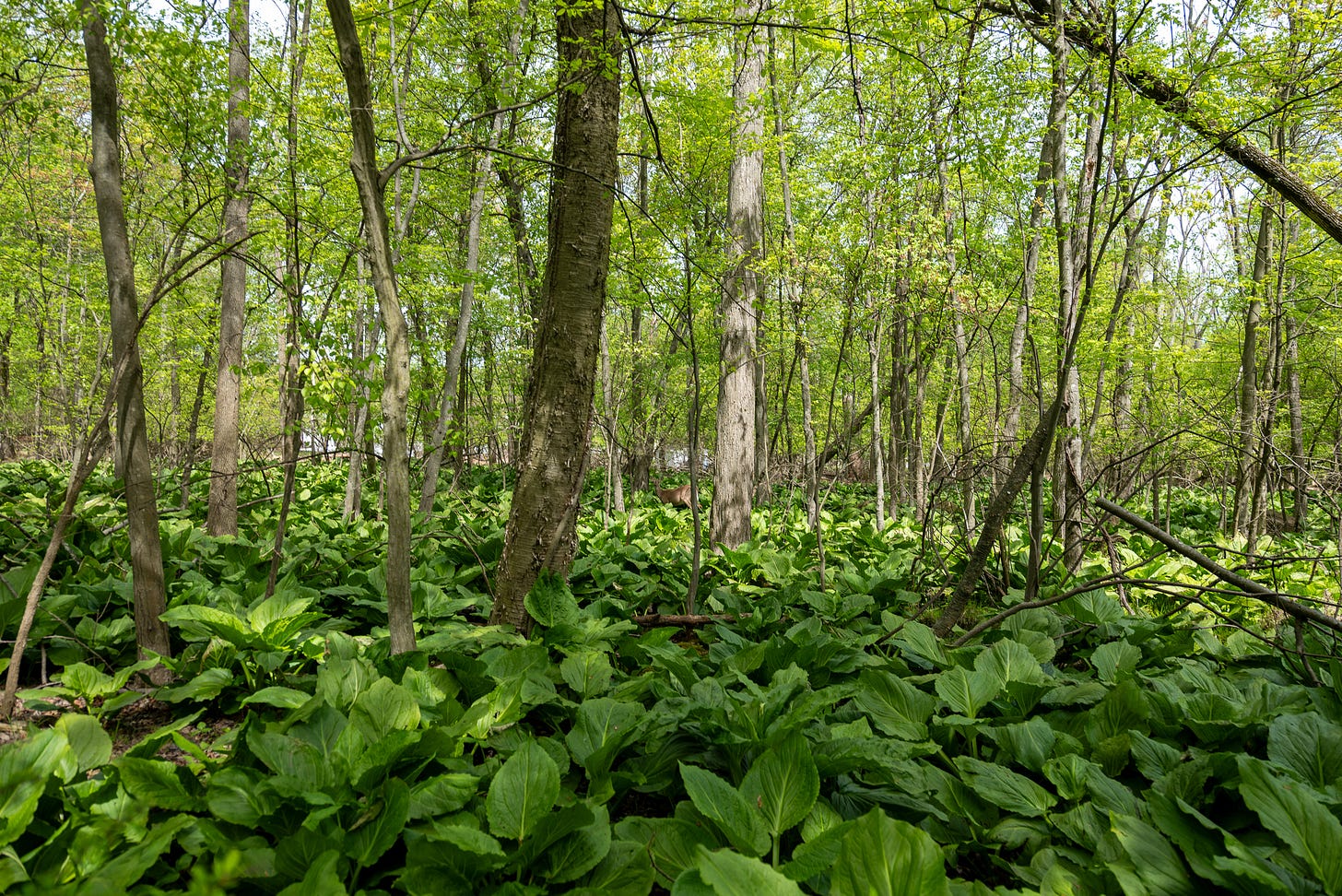
With this in mind, I visited a swampy area in Cedar Grove, New Jersey, on the other side of First Mountain, the hill on which Highland House and I are located, directly opposite the massive, monumental embankment of the Newark Reservoir. Even if this was above the shore of the vanished Glacial Lake Passaic, it is an overlooked place, unconquered by the machine, something it shares with the remnants of Glacial Lake Passaic at the Great Swamp, Troy Meadows, and Great Piece Meadows. Left an unnamed nature resereve because of its undesirable topography, this area is nevertheless heavily impacted by mountain bikers, who build strange structures in the area and create ruts in the surface. Most native plants have been decimated by deer overpopulation, replaced by invasives such as Pachysandra terminalis (Japanese pachysandra), Vinca minor(Periwinkle), and Berberis thunbergii, (Japanese barberry, which I think should be renamed “prickbush” for its thorns or perhaps “tickbush” for sheltering Lyme-disease-bearing ticks). Here, skunk cabbage rises in its full grandeur—a prehistoric apparition seemingly born of the mind of H. P. Lovecraft. The robust, mottled spathe, part vegetal cathedral, part biological aberration, enfolds the mysterious flower within, celebrating spring’s arrival. Unlike these invaders, skunk cabbage performs a crucial ecological role. Emerging during late winter and early spring, its thermogenic flowers lure early pollinators—flies, beetles, and bees—seeking warmth and sustenance when little else blooms. These insects, drawn to the flower’s pungent, decaying odor, find shelter and warmth within its spathe, inadvertently pollinating the plant as they visit. I saw a bee—probably a European honeybee, itself an invader, but at least a useful one for humans—hovering around during my visit.
This is not far from where the pioneer of Land Art, Robert Smithson grew up, so it’s hard not to think in his entropic terms even if he wrote about geology, rarely speaking of botany. He would, however, have been fascinated by skunk cabbage’s thermogenic properties, generating heat internally as if mocking entropy, defying the cold encroachments of snow and ice. Here, nature parodies technological efficiency, reducing steam engines and electrical heaters to botanical absurdities. Named by Linnaeus himself, Symplocarpus foetidus is at once a living machine and a vegetal alchemist, transmuting stagnant water and mud into heat and pungent gases, aligning itself with the decay and entropy it momentarily defies. The landscape of the skunk cabbage is dialectical, a complex interplay of wet and dry, decay and growth, warmth and chill. It illustrates a cyclical reality, where boundaries of past and future blur into endless biological permutations. It is this dialectic that aligns skunk cabbage with places the colonizing settlers would have deliberately avoided—places of entropy, of sublime revulsion, where the vegetal and geological become indistinct.
Skunk cabbage thrives in these margins, the spaces that civilization leaves behind or deems worthless, spaces that I discussed in my 2021 project “Wastelands.” Growing amid soggy grounds and neglected waterways, the plant is unnoticed by most residents of this area. Its flowers, alone among our native plants to have a tropical appearance, emerge out of frigid waters, defying seasonal expectations and climatic logic. Vibrant leaves, wide and lush, emerge later, giving the plant an almost deceptive allure, a kind of false beauty meant to distract or confuse. After it leafs out later in the spring, skunk cabbage looks tempting to eat, but the massive quantities of calcium oxalate its leaves contain will deliver an unforgettable feeling of eating ground glass to anyone sampling it, a feeling that may last up to two days. Early European settlers generally regarded skunk cabbage with disdain, considering it indicative of undesirable marshland—places they actively avoided, drained, or marginalized. This contrasts sharply with Indigenous perspectives, including the Lenape, who viewed the plant with respect, utilizing its as both medicine and seasoning.
Thermogenesis is exceedingly rare among plants. Aside from skunk cabbage, few species display such an adaptation; one notable example is the famous Sumatran Amorphophallus titanum, the Titan Arum, commonly called “the Corpse Flower,” or “Corpse Plant,” the world’s largest flower, which similarly produces heat and a foul scent to attract pollinators and oddity lovers. Both Skunk Cabbage and Corpse Flower are arums, an ancient family of plants generally found in the tropics (Arisaema triphyllum, Jack-in-the-Pulpit and Calla palustris, Water arum are notable exceptions). Smithson would say that skunk cabbage blurs the lines—lines between plant and animal, machine and organism, beauty and repulsion. Its heat-generating ability hints at a mechanical process, yet it remains undeniably organic, tethered to a primordial essence that evokes ancient landscapes predating humanity. In the marshy margins, the skunk cabbage quietly undermines human conceptions of aesthetic order. The opposite of what is traditionally valued in a flower, it nevertheless defines a botanical monumentality, reminding us that what we consider wastelands and confine to the outer edges of consciousness are areas teeming with life. Skunk cabbage remains both emblematic and enigmatic, existing as an organic sculpture that neither seeks nor requires acknowledgment, yet continuously shapes the marshy realms of its domain.
As I drove away, two workers on a nearby corner wielded gas-powered leaf blowers to fill the air with dust, not leaves. Their pointless combustion mimicked the skunk cabbage’s thermogenesis, but instead of sustaining life, this energy scattered dead matter into clouds of grit. With the old ritual day of Ash Wednesday coming, the dust became symbolic, a bleak reminder: from dust we came and to dust we shall return—our rituals of order futile against the quiet entropy reclaiming all we disturb.

